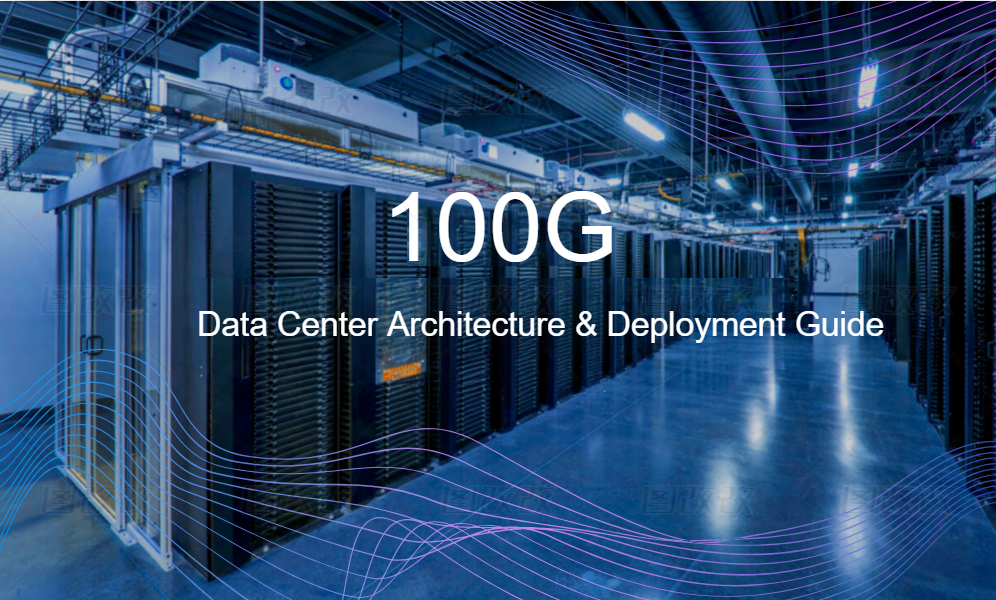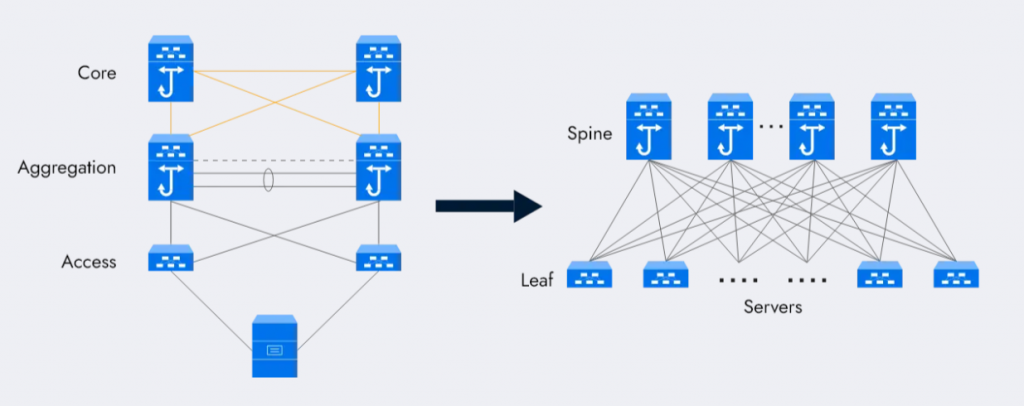
Upgrading your data center network to 100 Gigabit Ethernet (100G) is now not a luxurious however a necessity for a lot of fashionable enterprises. As mentioned in our earlier publish
“When to Improve to 100G“, the relentless progress of information site visitors, fueled by cloud computing, video streaming, real-time functions, and notably the surge in AI/ML workloads, is quickly outstripping the capabilities of conventional 10G and 40G networks.
This publish serves as your sensible information, breaking down the important elements and concerns for the best way to construct a 100G information heart. We’ll delve into structure, cabling methods, and essential gear choice, offering actionable insights for community engineers, IT managers, and enterprise patrons getting ready for this vital improve.
Understanding 100G Knowledge Middle Structure
The foundational design of your information heart community is paramount for reaching optimum 100G efficiency. Whereas older three-tier architectures (Core-Aggregation-Entry) as soon as dominated, the calls for of contemporary high-bandwidth, low-latency functions have pushed an evolution in direction of flatter, extra environment friendly topologies.
The Energy of Backbone-Leaf Topology
The Backbone-Leaf structure has emerged because the de facto normal for 100G information facilities attributable to its skill to ship ultra-low latency, non-blocking throughput, and linear scalability. This design provides quite a few benefits over conventional fashions by guaranteeing any-to-any connectivity, lowering congestion, and considerably bettering community resilience.
- Leaf Switches: These are the entry layer switches, deployed on the high of every rack (ToR), straight connecting to servers and storage models. In a 100G atmosphere, leaf switches sometimes present 25G or 50G downstream ports to servers, with 100G uplinks to the backbone layer. For instance, the Asterfusion CX308P-N is a leaf (ToR) swap with 48x25G downlink ports and 8x100G QSFP28 uplinks.
- Backbone Switches: Forming the spine of the 100G community, backbone switches interconnect all leaf switches. Every leaf swap connects to each backbone swap, creating a number of energetic paths for information stream. This redundancy ensures that if one path fails, information can merely take one other, enhancing resilience and lowering bottlenecks.
Selecting the Proper Architectural Layer Chipsets
The efficiency coronary heart of your 100G switches lies of their Utility-Particular Built-in Circuits (ASICs) and CPU. Completely different ASICs are optimized for distinct use circumstances:
- Marvell Teralynx 7: Best for ultra-low-latency, high-performance environments like AI coaching and inference clusters, Excessive-Frequency Buying and selling (HFT) techniques, and monetary backbones. It provides latency as little as 400-520 nanoseconds (e.g., Asterfusion CX564P-N at 400ns, CX532P-N at 520ns), huge packet throughput as much as 6300 Mpps, and a big 70MB packet buffer for superior congestion tolerance in lossless Ethernet situations like RoCEv2. This ASIC fits backbone or core layers in latency-sensitive information heart materials.
- Marvell Falcon (Prestera CX 8500): Optimized for scalable, cloud-driven networks and large-scale, multi-tenant virtualized information heart environments. Falcon-based switches supply excessive routing desk capacities (e.g., 288K IPv4 and 144K IPv6 routes) and 128K MAC tackle entries, essential for managing hundreds of VMs, containers, and overlay networks (VXLAN EVPN). Appropriate for backbone/leaf layers or edge routers, in addition to ToR or leaf swap roles.
Cabling Your 100G Knowledge Middle
The transition to 100G requires a sturdy cabling infrastructure, primarily counting on fiber optics.
1. Fiber Optic Foundations: SMF vs. MMF
Fiber optic cables kind the spine of 100G networks, carrying extra information over longer distances than copper.
- Multi-Mode Fiber (MMF): Used for shorter distances (as much as 150-300m) inside information facilities and LANs. MMF transmits a number of gentle modes, providing excessive bandwidth however extra dispersion over lengthy distances.
- Single-Mode Fiber (SMF): Makes use of a single gentle mode, excellent for long-distance transmission (as much as 40 km) with minimal sign loss.
2. Fiber Varieties and Cabling Suggestions
| Fiber Sort | Max Distance | Connector Sort | Typical Use Case |
|---|---|---|---|
| MMF (OM3/OM4/OM5) | 150-300m | LC, MPO-12/24 | Brief intra-data heart hyperlinks |
| SMF (OS1/OS2) | As much as 40 km | LC, MPO-12/24 | Lengthy-haul and inter-data heart |
| DAC | As much as 7m | Built-in | Brief rack/cupboard connections |
| AOC | As much as 100m+ | Built-in | Excessive-performance, low energy |
3. 100G Transmission Modes and Connectors
The QSFP28 transceiver kind issue is the popular alternative for environment friendly and highly effective 100G connectivity. QSFP28 ports supply excessive density and assist speeds together with 100GbE, 50GbE, and 25GbE. Its breakout functionality permits splitting a single 100G port into 4 25G or 4 10G connections, maximizing port utilization.
Completely different 100G Ethernet requirements dictate cabling necessities:
- 100GBASE-SR4: 4 lanes of 25G utilizing MTP/MPO-12 cabling.
- 100GBASE-SR10: 10 lanes of 10G utilizing MTP/MPO-24 cabling.
- Fiber sorts OM3, OM4, and OM5 assist varied charges and distances accordingly.
4. The Function of DAC and AOC Cables
- AOCs mix optical fiber, transceivers, and management chips to transform electrical indicators to optical with larger efficiency and decrease energy consumption. They’re light-weight and resistant to electromagnetic interference.
- DACs are cost-effective for short-distance connections, notably for 10G, 25G, and 40G hyperlinks.
AddOn Networks and Asterfusion present a variety of 100G optical modules and cables, together with short-reach, long-reach, and energy-efficient (“inexperienced”) choices with lifetime warranties and broad vendor compatibility.
Choosing Your 100G Tools
Key concerns when selecting 100G switches embody:
- Efficiency: ASICs and CPU
Excessive throughput and ultra-low latency ASICs like Marvell Teralynx 7 or Falcon make sure the swap can deal with demanding AI, HPC, or cloud workloads. The CPU should handle management aircraft duties effectively.
- Port Flexibility: The QSFP28 Benefit
QSFP28 helps excessive port density, multi-speed connections (100G, 50G, 25G), and breakout functionality, maximizing area and funding. For example, Asterfusion CX532P-N options 32x100G QSFP28 ports, and CX564P-N has 64x100G ports.
- Energy Effectivity and Cooling
Search for hot-swappable energy provides and followers, superior cooling like Energy to Connector (P2C) airflow, and “inexperienced” transceivers that minimize energy consumption by ~30%.
- Community Working System (NOS)
Open NOS like SONiC and Cumulus Linux present flexibility, automation, and feature-rich environments. Asterfusion switches come pre-installed with enterprise-grade SONiC NOS, supporting superior options like VXLAN, BGP EVPN, RoCEv2, and automation APIs. NVIDIA Mellanox integrates tightly with Cumulus Linux for programmable networks. MikroTik makes use of RouterOS, identified for personalisation however with a studying curve.
Selecting 100G Transceivers
QSFP28 transceivers convert electrical to optical indicators for fiber hyperlinks. Select transceivers primarily based on attain, fiber sort, and energy wants. AddOn Networks provides various 100G transceivers (brief attain, inexperienced, lengthy attain) with lifetime guarantee, and Asterfusion helps varied optics and cabling.
Main 100G Swap and Tools Distributors
| Vendor | Strengths | Concerns |
|---|---|---|
| Cisco | Market chief, safety, AI options | Larger value, complexity |
| Arista | Extremely-low latency, cloud-native | Premium pricing |
| Juniper | Safety, AI automation | Smaller ecosystem |
| HPE | Vitality environment friendly, P2C airflow | Fewer ultra-low latency fashions |
| Asterfusion | Value-effective, ultra-low latency | Newer model |
| NVIDIA Mellanox | Automation, HPC focus | Cloud/HPC targeted |
| MikroTik | Customizable, reasonably priced | Steeper studying curve |
Migrating from 10G/40G to 100G
Upgrading may be advanced, however with correct planning, 100G provides simplified structure and scalability.
1. Seamless Integration and Scalability
100G ports can exchange a number of 10G or 40G hyperlinks, lowering gadgets and complexity. Breakout ports and backward compatibility allow gradual migration. Current fibers are sometimes reusable, minimizing expensive rip-and-replace efforts.
2. Harnessing RoCE for Lossless Efficiency
Distant Direct Reminiscence Entry over Converged Ethernet (RoCEv2) offers lossless Ethernet by offloading CPU and managing congestion, decreasing latency and jitter—essential for storage, AI, and HPC clusters.
Key options embody:
- Precedence Movement Management (PFC)
- Specific Congestion Notification (ECN)
- Enhanced Transmission Choice (ETS)
- Knowledge Middle Bridging Trade (DCBX)
Asterfusion CX-N switches assist RoCEv2 with latency outperforming some InfiniBand switches.
Actual-World Situations and Advantages
- Powering AI, HPC, and Monetary Workloads
100G with ultra-low latency ASICs and RoCEv2 meets calls for of AI coaching clusters, HPC, and high-frequency buying and selling information facilities requiring minimal latency and most throughput.
- Enhancing East-West Site visitors and Cloud Scalability
Backbone-leaf topology handles heavy server-to-server (east-west) site visitors effectively. Marvell Falcon switches with giant routing tables and MAC capacities assist multi-tenant cloud environments and overlay networks.
- Addressing Sensible File Switch Wants
Native file servers with 100G considerably velocity transfers and backups, fixing sync points and bettering productiveness.
Overcoming Challenges in 100G Deployment
- Preliminary Funding and Lengthy-Time period Worth
Excessive upfront prices for switches, transceivers, and infrastructure are offset by scalability, diminished downtime, and operational financial savings.
- Energy Administration and Operational Complexity
Choose energy-efficient gear and superior cooling (e.g., P2C airflow, chilly batteries). Open NOS like SONiC simplifies administration and monitoring, easing operational burden.
FAQ
Q1: What’s the major good thing about Backbone-Leaf structure in a 100G information heart?
A: Non-blocking, low-latency connectivity with linear scalability and improved resilience.
Q2: Can I reuse present fiber cabling when upgrading to 100G?
A: Usually sure, if cabling helps required fiber sorts and connectors.
Q3: How does RoCEv2 enhance 100G community efficiency?
A: By enabling lossless Ethernet, lowering latency and CPU load by means of congestion administration.
This fall: How a lot does it value to construct a small information heart?
The fee to construct a small information heart varies extensively relying on location, design, and capability. Usually:
- Development prices vary from $600 to $1,000 per sq. foot.
- Per MW IT load, the price ranges from $7 million to $12 million.
- A 1,000 sq ft facility might value ~$1 million, whereas a small edge or micro information heart might value round $500,000 to $2 million relying on redundancy and connectivity wants.
Q5: How a lot does a 100 MW information heart value?
A 100 MW hyperscale information heart sometimes prices between $700 million and $1.2 billion, primarily based on a regular estimate of $7 million to $12 million per MW of IT load. Energy capability is a key constraint for information facilities, and large-scale amenities typically embody superior energy distribution, cooling, and community infrastructure to deal with huge workloads effectively.
Conclusion
Constructing a 100G information heart is a strategic funding that future-proofs your infrastructure. By rigorously planning your community structure with Backbone-Leaf design, deciding on applicable cabling and high-performance gear, and leveraging applied sciences like RoCE for lossless information switch, you’ll be able to unlock vital good points in velocity, scalability, and effectivity.
The transition from 10G/40G may be clean with considerate migration methods and versatile {hardware}. Whereas challenges exist, the advantages for AI, HPC, cloud, and enterprise workloads are simple.
Able to speed up your 100G deployment? Discover sensible options, structure designs, and transceiver choices on our dedicated 100G data center page.
👇Comply with extra 👇
👉 bdphone.com
👉 ultractivation.com
👉 trainingreferral.com
👉 shaplafood.com
👉 bangladeshi.help
👉 www.forexdhaka.com
👉 uncommunication.com
👉 ultra-sim.com
👉 forexdhaka.com
👉 ultrafxfund.com
👉 bdphoneonline.com
👉 dailyadvice.us




